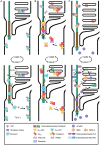On the Wrong Track: Alterations of Ciliary Transport in Inherited Retinal Dystrophies
- PMID: 33748110
- PMCID: PMC7973215
- DOI: 10.3389/fcell.2021.623734
On the Wrong Track: Alterations of Ciliary Transport in Inherited Retinal Dystrophies
Abstract
Ciliopathies are a group of heterogeneous inherited disorders associated with dysfunction of the cilium, a ubiquitous microtubule-based organelle involved in a broad range of cellular functions. Most ciliopathies are syndromic, since several organs whose cells produce a cilium, such as the retina, cochlea or kidney, are affected by mutations in ciliary-related genes. In the retina, photoreceptor cells present a highly specialized neurosensory cilium, the outer segment, stacked with membranous disks where photoreception and phototransduction occurs. The daily renewal of the more distal disks is a unique characteristic of photoreceptor outer segments, resulting in an elevated protein demand. All components necessary for outer segment formation, maintenance and function have to be transported from the photoreceptor inner segment, where synthesis occurs, to the cilium. Therefore, efficient transport of selected proteins is critical for photoreceptor ciliogenesis and function, and any alteration in either cargo delivery to the cilium or intraciliary trafficking compromises photoreceptor survival and leads to retinal degeneration. To date, mutations in more than 100 ciliary genes have been associated with retinal dystrophies, accounting for almost 25% of these inherited rare diseases. Interestingly, not all mutations in ciliary genes that cause retinal degeneration are also involved in pleiotropic pathologies in other ciliated organs. Depending on the mutation, the same gene can cause syndromic or non-syndromic retinopathies, thus emphasizing the highly refined specialization of the photoreceptor neurosensory cilia, and raising the possibility of photoreceptor-specific molecular mechanisms underlying common ciliary functions such as ciliary transport. In this review, we will focus on ciliary transport in photoreceptor cells and discuss the molecular complexity underpinning retinal ciliopathies, with a special emphasis on ciliary genes that, when mutated, cause either syndromic or non-syndromic retinal ciliopathies.
Keywords: ciliary transport; ciliopathy; inherited retinal dystrophies; intraflagellar transport; photoreceptor; sensory cilium.
Copyright © 2021 Sánchez-Bellver, Toulis and Marfany.
Conflict of interest statement
The authors declare that the research was conducted in the absence of any commercial or financial relationships that could be construed as a potential conflict of interest.
Figures




Similar articles
-
Protein networks and complexes in photoreceptor cilia.Subcell Biochem. 2007;43:209-35. doi: 10.1007/978-1-4020-5943-8_10. Subcell Biochem. 2007. PMID: 17953396 Review.
-
Non-syndromic retinal ciliopathies: translating gene discovery into therapy.Hum Mol Genet. 2012 Oct 15;21(R1):R111-24. doi: 10.1093/hmg/dds298. Epub 2012 Jul 26. Hum Mol Genet. 2012. PMID: 22843501 Review.
-
By the Tips of Your Cilia: Ciliogenesis in the Retina and the Ubiquitin-Proteasome System.Adv Exp Med Biol. 2020;1233:303-310. doi: 10.1007/978-3-030-38266-7_13. Adv Exp Med Biol. 2020. PMID: 32274763 Review.
-
Photoreceptor sensory cilia and ciliopathies: focus on CEP290, RPGR and their interacting proteins.Cilia. 2012 Dec 3;1(1):22. doi: 10.1186/2046-2530-1-22. Cilia. 2012. PMID: 23351659 Free PMC article.
-
Primary cilia biogenesis and associated retinal ciliopathies.Semin Cell Dev Biol. 2021 Feb;110:70-88. doi: 10.1016/j.semcdb.2020.07.013. Epub 2020 Jul 31. Semin Cell Dev Biol. 2021. PMID: 32747192 Free PMC article. Review.
Cited by
-
A comprehensive WGS-based pipeline for the identification of new candidate genes in inherited retinal dystrophies.NPJ Genom Med. 2022 Mar 4;7(1):17. doi: 10.1038/s41525-022-00286-0. NPJ Genom Med. 2022. PMID: 35246562 Free PMC article.
-
Specialization of the photoreceptor transcriptome by Srrm3-dependent microexons is required for outer segment maintenance and vision.Proc Natl Acad Sci U S A. 2022 Jul 19;119(29):e2117090119. doi: 10.1073/pnas.2117090119. Epub 2022 Jul 12. Proc Natl Acad Sci U S A. 2022. PMID: 35858306 Free PMC article.
-
Retinal Degeneration Animal Models in Bardet-Biedl Syndrome and Related Ciliopathies.Cold Spring Harb Perspect Med. 2023 Jan 3;13(1):a041303. doi: 10.1101/cshperspect.a041303. Cold Spring Harb Perspect Med. 2023. PMID: 36596648 Free PMC article. Review.
-
A Novel ARL3 Gene Mutation Associated With Autosomal Dominant Retinal Degeneration.Front Cell Dev Biol. 2021 Aug 17;9:720782. doi: 10.3389/fcell.2021.720782. eCollection 2021. Front Cell Dev Biol. 2021. PMID: 34485303 Free PMC article.
-
The Deubiquitinating Enzyme USP48 Interacts with the Retinal Degeneration-Associated Proteins UNC119a and ARL3.Int J Mol Sci. 2022 Oct 19;23(20):12527. doi: 10.3390/ijms232012527. Int J Mol Sci. 2022. PMID: 36293380 Free PMC article.
References
Publication types
LinkOut - more resources
Full Text Sources
Other Literature Sources

